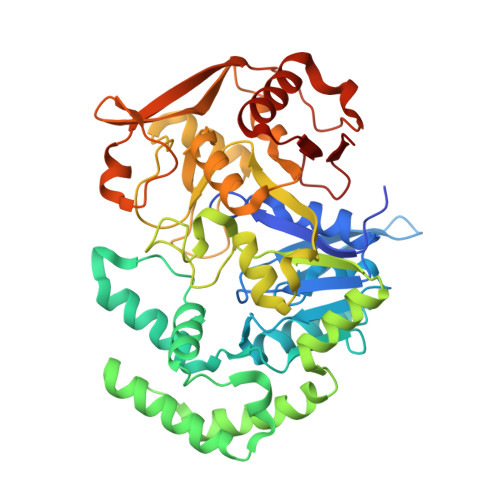Disruption of de Novo Adenosine Triphosphate (ATP) Biosynthesis Abolishes Virulence in Cryptococcus neoformans.
Blundell, R.D., Williams, S.J., Arras, S.D., Chitty, J.L., Blake, K.L., Ericsson, D.J., Tibrewal, N., Rohr, J., Koh, Y.Q., Kappler, U., Robertson, A.A., Butler, M.S., Cooper, M.A., Kobe, B., Fraser, J.A.(2016) ACS Infect Dis 2: 651-663
- PubMed: 27759389
- DOI: https://doi.org/10.1021/acsinfecdis.6b00121
- Primary Citation of Related Structures:
5I33, 5I34 - PubMed Abstract:
Opportunistic fungal pathogens such as Cryptococcus neoformans are a growing cause of morbidity and mortality among immunocompromised populations worldwide. To address the current paucity of antifungal therapeutic agents, further research into fungal-specific drug targets is required. Adenylosuccinate synthetase (AdSS) is a crucial enzyme in the adeosine triphosphate (ATP) biosynthetic pathway, catalyzing the formation of adenylosuccinate from inosine monophosphate and aspartate. We have investigated the potential of this enzyme as an antifungal drug target, finding that loss of function results in adenine auxotrophy in C. neoformans, as well as complete loss of virulence in a murine model. Cryptococcal AdSS was expressed and purified in Escherichia coli and the enzyme's crystal structure determined, the first example of a structure of this enzyme from fungi. Together with enzyme kinetic studies, this structural information enabled comparison of the fungal enzyme with the human orthologue and revealed species-specific differences potentially exploitable via rational drug design. These results validate AdSS as a promising antifungal drug target and lay a foundation for future in silico and in vitro screens for novel antifungal compounds.
Organizational Affiliation:
Australian Infectious Diseases Research Centre, School of Chemistry and Molecular Biosciences, The University of Queensland , Brisbane, Queensland 4072, Australia.
















